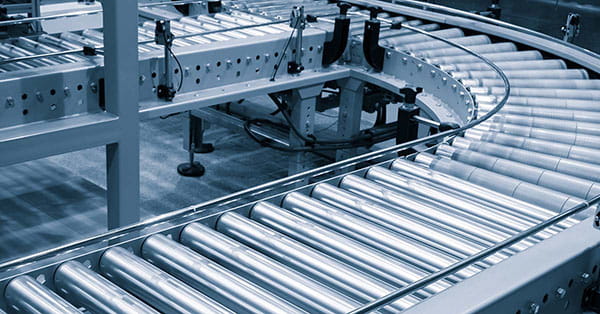Alabama Conveyor Systems Supplier
Conveyors and automated storage and retrieval systems can increase the performance of your warehouse, improve safety practices and meaningfully reduce human resource costs.
Today’s conveyor systems can transport both individual cartons and entire pallets within your warehouse, and they are a fundamental piece of modern material handling design.
Conveyor systems are classified in three distinct divisions for most material handling configurations:
- Powered belt or roller conveyor systems (for package handling)
- Powered chain or roller systems (for pallet handling)
- Non-powered conveyor systems
Powered Package Handling Roller or Belt Conveyors
Powered roller or belt systems are often used for smaller pieces like packages and cartons.
Conveyor belts are generally employed for advancing products along a line, while roller conveyors are used for collecting products in certain areas along the line.
Belt Conveyors
In use since the early 1900s, belt systems are an indispensable piece of many material handling systems. Lower cost than roller options and often better suited to specific tasks like advancing lighter weight items, belt conveyors have a place in most material handling layouts.
Belt systems utilize a long, looped belt that rides a series of non-powered rollers on a metal substructure called a slider belt. A motor drives a pulley that turns the belt and advances products down the conveyor line.
Conveyor belts are configured with an assortment of surfaces and materials according to the purpose and nature of the conveyor. For example, a belt surface could be perfectly smooth in portions where cartons need to glide off the line and may have a ridged surface on segments where items have to be moved up slopes.
Roller Conveyors
Despite the long and successful history of belt conveyors, newer roller systems offer a number of advantages in many modern material handling applications.
First and foremost, roller configurations can enable collection of objects on the line where belt configurations cannot. This is an important distinction because there are innumerable scenarios where products must decelerate and accumulate in material handling designs. Accumulation processes are often used when objects must be paused before being passed to automated palletizers or sorters.
Some roller systems also have the ability to supervise objects on the line and utilize zero pressure accumulation, meaning none of the products collecting on the line touch each other as they decelerate and finally stop.
Roller conveyors comprise several cylindrical rollers that are usually powered in one of three different ways:
- Line shaft conveyors: In a line shaft system, a long metal rod runs underneath the cylinders perpendicular to them and is attached to each cylinder with flexible O-rings. A motor rotates the shaft and consequently drives the rollers by way of the connected O-rings. Line shaft configurations are the most cost-efficient of all roller conveyors, but they can also demand the most service because the linkages between the rollers and the shaft tend to need adjustment and occasionally break.
- Belt-driven roller conveyors: As you may expect, these systems are powered by a belt that lies underneath the roller platform. A motor propels the belt, which propels the rollers.
- MDR conveyors: Motorized roller conveyors, frequently referred to as motor-driven roller (MDR) conveyors, are set up in segments where only one roller from each section is driven by its own power source. That one powered cylinder is joined to the others in that section via rubber O-rings, thereby driving all the cylinders in the segment. Motorized segments are placed in sequence to create the conveyor line.
Motorized roller conveyors are known for their energy efficiency because: a.) They generally are powered by 24-volt DC motors and b.) These motors can be set up to run only when an object is present on the rollers,and, as a result, they are motionless most of the time.
Although the cost of MDR conveyors is higher than belt drive and line shaft systems, energy expenses and service costs are typically quite a bit lower than the other options mentioned. - Segmented belt conveyor: The concept of MDR systems ultimately led to the birth of segmented belt conveyors. Similar to motor-driven roller conveyors, segmented belts are powered individually and offer several of the same advantages of MDRs, including accumulation potential.
Powered Pallet Handling Conveyors
Powered pallet handling conveyors are frequently coupled with palletizers and automatic storage and retrieval systems. Pallet handling conveyors can usually deal with loads of up to two tons and proceed at a much slower rate than package handling conveyors, many times at speeds as low as four pallets per minute.
Pallet handling conveyors come in two types: chain conveyors and roller conveyors.
- Pallet handling chain conveyor: Perhaps the most rudimentary of all conveyor methods, pallets on a chain conveyor line sit on top of segments of heavy-duty chain. A drive mechanism advances the lengths of chain which in turn move the pallets along the line.
- Pallet handling roller conveyor: Analogous to motor-driven roller conveyors, pallet handling roller systems use larger rollers and sturdy chains to connect the powered roller to the rest of the rollers in a conveyor section.
Non-Powered Conveyors
Roller or skatewheel systems are the most prevalent types of non-powered conveyors used in material handling. These types of systems use inertia and gravity to move smaller items though pick modules, warehouses, workstations, automated sorters, loading docks and package-sorting areas.
Skatewheel conveyors comprise many individual wheels and need minimal power to maintain the inertia of objects as they move down a conveyor line. In general, they move products faster than non-powered roller conveyors, and they have more versatility when it comes to configuration. Because they’re individual wheels instead of a belt, they can be applied in curvilinear sections of a conveyor arrangement.
Generally, non-powered roller systems are less costly than skatewheel conveyor configurations. They’re often used for workstations, pick modules and other sectors where it’s beneficial to maintain a level platform to perform tasks. Roller conveyors also slow products down that originate from higher speed mechanisms like sorters so that employees can keep up with system performance.
Non-powered skatewheel and roller conveyors have a significant handicap in comparison to powered conveyors: By using gravity and inertia to move items, you lose the ability to directly manage the force applied to those materials. In other words, you have very little influence on the inertia and speed of products on your conveyor line.
Conveyor Companies Near Me
If you’d like a complete evaluation of conveyor system options for your warehouse, distribution center or other material handling operation, contact an expert at Carolina Handling.
-
-
Proudly serving
Mobile, Saraland,
Daphne, Fairhope, Foley,
Gulf Shores, Pensacola (FL),
Jackson, Monroeville, Evergreen,
Andalusia, Dothan, Blakely,
and the entire State of Alabama.
You May Also Like:
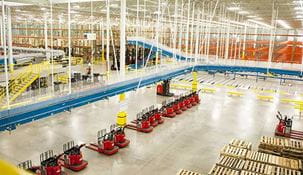
Automation
Carolina Handling can help you automate every aspect of your warehouse operation to increase efficiency.
Learn More
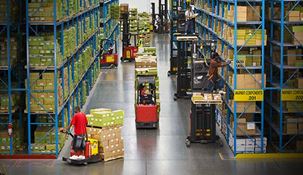
Optimization
Optimize everything in your warehouse to improve productivity and reduce operating costs.
Learn More
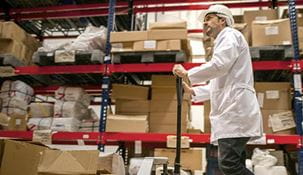
Warehouse Products
Looking for the right product for your operation? We have everything you need to do business in stock.
Learn More
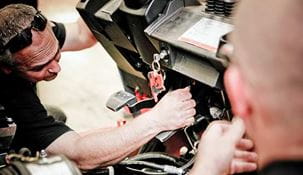
Service Maintenance
Providing superior lift truck service and maintenance for our customers is Carolina Handling's highest priority.
Learn More


